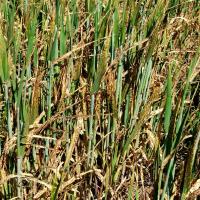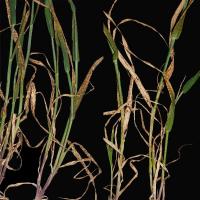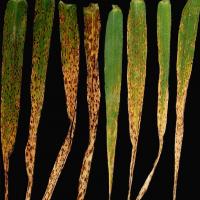Diagnosing boron toxicity in barley
Boron toxicity is usually an inherent feature of a soil and is a particular problem when high boron levels occur in the subsoil. In Western Australia, boron toxicity occurs most commonly in the mallee regions north of Esperance, and on morrel soils around the south eastern lakes area and the eastern wheatbelt.
What to look for
- Plants with severe physiological leaf spot symptoms in spring, on heavy highly alkaline clay or lake edge loamy soils.
- Symptoms are worst in seasons where plants depend on subsoil moisture to finish.
Paddock
- Symptoms appear first and most severely on oldest leaves.
- Boron toxicity appears as small dark spots, often located more towards the tip and along the margins of the leaf. In some cases these spots have a yellow margin.
Plant
What else could it be
| Condition | Similarities | Differences |
|---|---|---|
| Diagnosing physiological leaf spot in barley | Numerous brownish lesions on older leaves | Boron toxicity occurs on certain highly alkaline soils, and the lesions are spread more evenly on the edges and end of the leaf. |
| Diagnosing spot type net blotch | Small brown lesions with yellow margins on older leaves | Spot type net blotch lesions will enlarge and destroy the leaf, however the disease usually occurs earlier in the season and is not soil type specific. |
Where does it occur?

Soil type

Dry conditions
- Boron toxicity is an inherent characteristic of some soils especially those formed from marine or wind-blown sediments that have an alkaline sodic subsoil.
- Boron toxicity is more prevalent in dry seasons and in years with mid-season drought when crops rely on deep subsoil moisture.
- Boron is more likely to be a problem when it is present closer to the soil surface, where roots encounter high levels of boron in the early stages of development or as seedlings.
- Boron toxicity may be caused by adding boron-rich subsoil to non-wetting sandy topsoils as occurs with claying, but this is unlikely to remain an ongoing problem.
Management strategies
- It is not economically viable to treat boron toxicity in broadacre cropping systems and the constraint is best overcome by sowing crops and barley varieties more tolerant of high boron levels.
How can it be monitored?

Tissue test

- Identifying boron toxicity using tissue testing is difficult due to the uneven distribution of boron throughout the plant. However, boron concentration in whole shoots sampled at the boot stage of greater than 70 milligrams per kilogram (mg/kg) indicates boron toxicity.
- The concentration in harvested grain can be a more reliable method of assessing boron toxicity in cereals. A concentration of greater than 3 mg/kg indicates probable toxicity.
- The standard laboratory method for extracting boron from soils using hot calcium chloride solution provides an accurate reflection of the soil boron level in the sample. However, standard topsoil testing is unreliable because boron levels increase with depth, and boron levels can vary widely across the soil.
Further information
Where to go for expert help
Page last updated: Wednesday, 4 February 2015 - 11:44am




